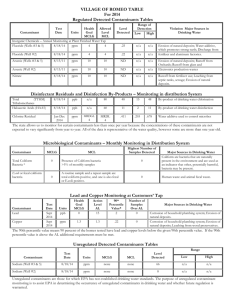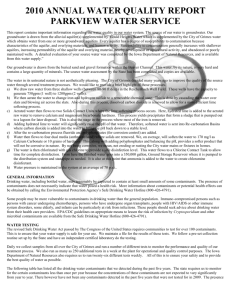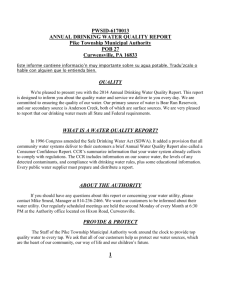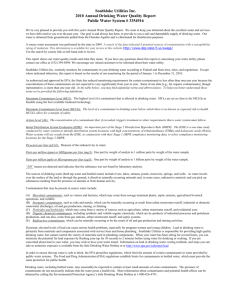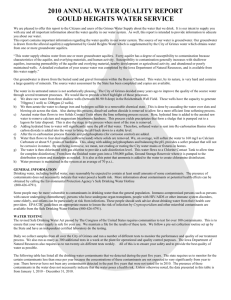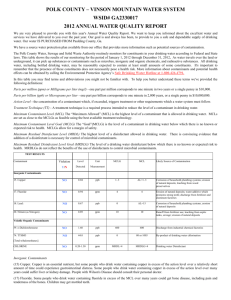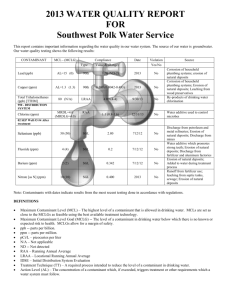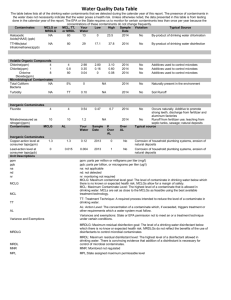2014 Annual Water Quality Report
advertisement
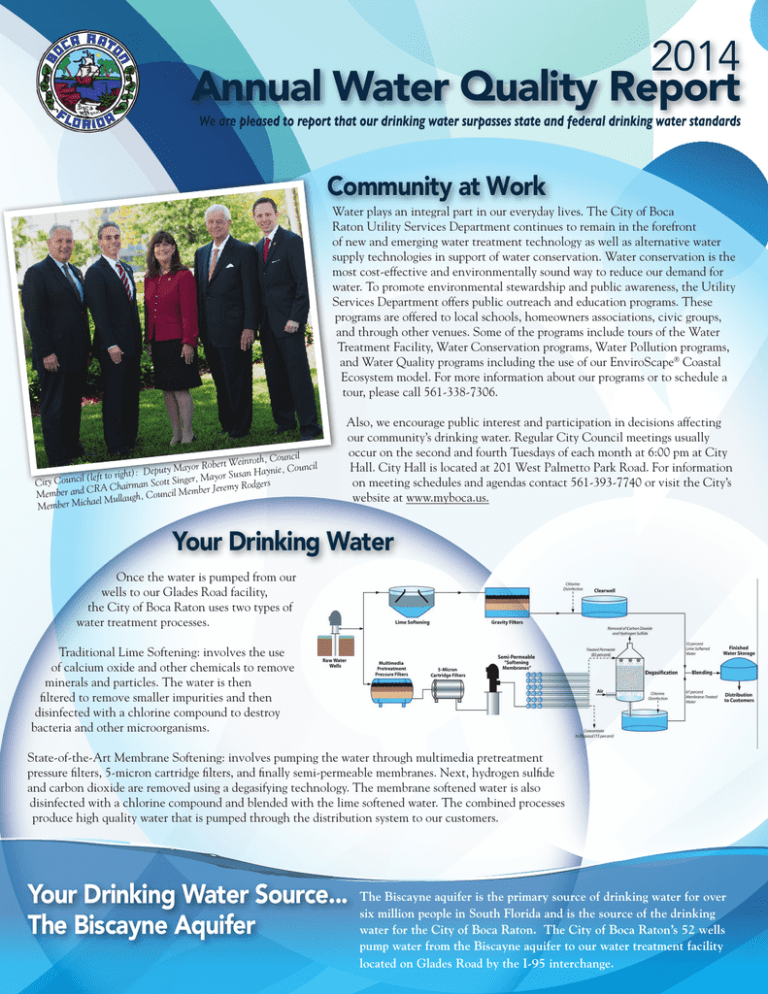
2014 Annual Water Quality Report We are pleased to report that our drinking water surpasses state and federal drinking water standards Community at Work Water plays an integral part in our everyday lives. The City of Boca Raton Utility Services Department continues to remain in the forefront of new and emerging water treatment technology as well as alternative water supply technologies in support of water conservation. Water conservation is the most cost-effective and environmentally sound way to reduce our demand for water. To promote environmental stewardship and public awareness, the Utility Services Department offers public outreach and education programs. These programs are offered to local schools, homeowners associations, civic groups, and through other venues. Some of the programs include tours of the Water Treatment Facility, Water Conservation programs, Water Pollution programs, and Water Quality programs including the use of our EnviroScape® Coastal Ecosystem model. For more information about our programs or to schedule a tour, please call 561-338-7306. ouncil t Weinroth, C Mayor Rober y e, Council ut ni ep ay D H ): n sa (left to right er, Mayor Su ng Si t ot Sc City Council an remy Rodgers CRA Chairm il Member Je Member and laugh, Counc ul M el ha ic Member M Also, we encourage public interest and participation in decisions affecting our community’s drinking water. Regular City Council meetings usually occur on the second and fourth Tuesdays of each month at 6:00 pm at City Hall. City Hall is located at 201 West Palmetto Park Road. For information on meeting schedules and agendas contact 561-393-7740 or visit the City’s website at www.myboca.us. Your Drinking Water Once the water is pumped from our wells to our Glades Road facility, the City of Boca Raton uses two types of water treatment processes. Traditional Lime Softening: involves the use of calcium oxide and other chemicals to remove minerals and particles. The water is then filtered to remove smaller impurities and then disinfected with a chlorine compound to destroy bacteria and other microorganisms. State-of-the-Art Membrane Softening: involves pumping the water through multimedia pretreatment pressure filters, 5-micron cartridge filters, and finally semi-permeable membranes. Next, hydrogen sulfide and carbon dioxide are removed using a degasifying technology. The membrane softened water is also disinfected with a chlorine compound and blended with the lime softened water. The combined processes produce high quality water that is pumped through the distribution system to our customers. Your Drinking Water Source... The Biscayne Aquifer The Biscayne aquifer is the primary source of drinking water for over six million people in South Florida and is the source of the drinking water for the City of Boca Raton. The City of Boca Raton’s 52 wells pump water from the Biscayne aquifer to our water treatment facility located on Glades Road by the I-95 interchange. Source Water Assessments Drop Savers In 2014, the Florida Department of Environmental Protection (DEP) performed a Mayor Susan Haynie Source Water Assessment on the City’s wellfield system in order to ensure our source proclaimed April 2015 as water is protected. The assessment was conducted to provide information about any Water Conservation Month, potential sources of contamination in the vicinity of the City’s wells. Potential May 3rd 9th as Drinking sources of contamination are those facilities, sites, and activities that have the Water Week, and May 17th - 23rd potential to affect the underlying ground water aquifers or nearby surface waters as Water Reuse Week during the used for public drinking water supply. Many of these potential sources are April 28, 2015 City Council meeting. regulated by DEP and the location and status of these sites are maintained Along with this proclamation, the Utility within DEP databases. By utilizing in-house databases and a geographical Services Department held a Drop Savers information system (GIS), DEP can access and illustrate the relationships Water Conservation Poster Contest in which over of potential contaminant sources to the approximately 12,000 public water 1,000 children, grades K 5, from seven local schools supply intakes in Florida. participated. The children designed amazing water conservation themed posters. Three of the children’s It should be noted that the potential sources of contamination identified by posters were selected for entry in the Florida Section this assessment project are just that; potential sources. Many of these facilities of the American Water Works Association’s statewide are regulated and operate under stringent construction and maintenance poster contest. requirements designed to protect both human health and the environment. The purpose of conducting the source water assessments is to provide information that will lead to actions to reduce current risks or avoid future problems. The DEP has identified twenty-six unique potential sources of contamination for the City’s wellfield system with a moderate or a low susceptibility level. The assessment results and more information is available on the DEP Source Water Assessment and Protection Program website at www.dep.state.fl.us/ swapp or can be obtained by calling the Utility Services Department at 561-338-7310. Immuno-Compromised Person Some people may be more vulnerable to contaminants in drinking water than the general population. Immuno-compromised persons such as persons with cancer undergoing chemotherapy, persons who have undergone organ transplants, people with HIV/AIDS or other immune system disorders, some elderly, and infants can be particularly at risk from infections. These people should seek advice about drinking water from their health care providers. EPA/CDC guidelines on appropriate means to lessen the risk of infection by Cryptosporidium and other microbial contaminants are available from the Safe Drinking Water Hotline 1-800-426-4791. K-1 Entrant: Kasi Pope, St. Joan of Arc 2-3 Entrant: Edgar Handal, St. Joan of Arc 4 -5 Entrant: Sophia Simoes, Pine Crest Qualit y Data e Water h t Table f o n o i t The City of Boca Raton Utility Services plana Department routinely x monitors for contaminants in your E An drinking water according to Federal and State laws, rules, and regulations. The table on the next page shows the results of our water quality analysis. Except when indicated otherwise, this report is based on the results of our monitoring for the period of January 1, 2014 to December 31, 2014. Data obtained before January 1, 2014 and presented in this report are from the most recent testing done in accordance with laws, rules, and regulations. The table contains: the name of each substance; the maximum contaminant level (MCL) or the highest level allowed by regulation; the ideal goals for pubic health; the amount detected; the usual sources of such contamination; footnotes that explain our findings; and a key to units of measurement. The MCLs are set at very stringent levels. 2014 Water Quality Table 2014 Water Quality Table Microbiological Contaminants Contaminant and Unit Contaminants of Microbiological Dates of sampling (mo./yr.) Measurement Contaminant and Unit of Microbiological Contaminants Dates of sampling (mo./yr.) Measurement Total Coliform Bacteria 6/14 (% positive samples) Contaminant and Unit of Dates of sampling (mo./yr.) Total Coliform Bacteria Measurement 6/14 (% positive samples) Inorganic Contaminants MCL Violation Y/N MCL Violation Y/N N MCL Violation N Y/N MCL N Violation Y/N MCL Contaminant and Unit of Violation Inorganic Fluoride Measurement (ppm) Contaminants Dates of sampling 2/14 (mo./yr.) N Y/N MCL Contaminant and (ppm) Unit of Nitrate (as Nitrogen) 2/14 N Dates of sampling Violation Fluoride Measurement (ppm) 2/14 (mo./yr.) N Y/N Sodium (ppm) 2/14 N Nitrate (as Nitrogen) (ppm) 2/14 N Fluoride (ppm) 2/14 Stage 2 Disinfectants and Disinfection By-Products NN Sodium (ppm) 2/14 Nitrate (as Nitrogen) (ppm) 2/14 N or MCL Stage 2 Disinfectants and Dates Disinfection By-ProductsMRDL Disinfectant or Contaminant of sampling Sodium (ppm) 2/14 (mo./yr.) N and Unit of Measurement Violation MCL or Y/N Disinfectant or Contaminant MRDL Stage 2 Disinfectants and Dates Disinfection By-Products of sampling (mo./yr.) and Unit of(ppm) Measurement Violation Chloramines 2014 N MCL Y/Nor Disinfectant or Contaminant MRDL MCL (mo./yr.) Contaminant and Unit of LocationDates Site of sampling Chloramines 2014 N and Unit of(ppm) Measurement Violation Dates of sampling (mo/yr) Measurement # Y/N (Y/N) MCL Contaminant and Unit of Location Site Dates of6/14, sampling (mo/yr) Violation Chloramines (ppm) 2014 1 3/14, 9/14, 12/14 N Measurement # (Y/N) MCL 2 3/14, 6/14, 9/14, 12/14 N Contaminant and Unit of Location 1 Site Dates 3/14,of6/14, 9/14, 12/14 N sampling (mo/yr) Violation Measurement 3# 3/14, 6/14, 9/14, 12/14 N (Y/N) 2 3/14, 6/14, 9/14, 12/14 N Haloacetic Acids (HAA5) (ppb) 41 3/14, 6/14, 9/14, 12/14 N 3 3/14, 6/14, 9/14, 12/14 N 52 3/14, 6/14, 9/14, 12/14 N Haloacetic Acids (HAA5) (ppb) 4 3/14, 6/14, 9/14, 12/14 N 63 3/14, 6/14, 9/14, 12/14 N 5 3/14, 6/14, 9/14, 12/14 N Haloacetic Acids (HAA5) (ppb) 14 3/14, 6/14, 9/14, 12/14 N 6 3/14, 6/14, 9/14, 12/14 N 25 3/14, 6/14, 9/14, 12/14 N 1 3/14, 6/14, 9/14, 12/14 N 36 3/14, 6/14, 9/14, 12/14 N Total Trihalomethanes 2 3/14, 6/14, 9/14, 12/14 N (TTHM) (ppb) 41 3/14, 6/14, 9/14, 12/14 N 3 3/14, 6/14, 9/14, 12/14 N Total Trihalomethanes 52 3/14, 6/14, 9/14, 12/14 N (TTHM) (ppb) 4 3/14, 6/14, 9/14, 12/14 N 63 3/14, 6/14, 9/14, 12/14 N Total Trihalomethanes 5 3/14, 6/14, 9/14, 12/14 N (TTHM) (ppb) 4 3/14, 6/14, 9/14, 12/14 N Lead and Copper (Tap Water) 6 3/14, 6/14, 9/14, 12/14 N 5 3/14, 6/14, 9/14, 12/14 N AL Lead and Copper Contaminant and Unit of (Tap Water) (mo./yr.) Exceeded 6 Dates of sampling 3/14, 6/14, 9/14, 12/14 N Measurement (Y/N) AL Contaminant and Unit of (Tap Water) Lead and Copper Dates of sampling (mo./yr.) Exceeded Measurement Copper (tap water) (ppm) 7/14 N (Y/N) AL Contaminant and Unit of Dates of sampling (mo./yr.) Exceeded Lead (tapMeasurement water) (ppb) 7/14 N Copper (tap water) (ppm) 7/14 N (Y/N) 1. RAA - Running Annual Average 2. LRAA - Location Running Annual Average Lead (tap water) (ppb) 7/14 N Copper (tap water) (ppm) 7/14 N 1. RAA - Running Annual Average 2. LRAA - Location Running Annual Average Lead (tap water) (ppb) 7/14 N Total Coliform Bacteria Contaminant and Unit of Inorganic Contaminants (% positive samples) Measurement 6/14 (mo./yr.) Dates of sampling Highest Monthly Percentage 2014 Water Quality Table MCLG MCL Likely Source of Contamination MCLG 0 MCL 5% Likely Source of Contamination Naturally present in the environment MCLG 0 MCL 5% Likely Source of Contamination Naturally present in the environment Level 3.70% Range of Detected Results 0 MCLG 5% MCL Naturally present in the environment Likely Source of Contamination Level 0.12 Detected Range of N/A Results MCLG 4 MCL 4 Erosion of natural deposits; discharge from fertilizer and aluminum factories. Water Likely Source of Contamination additive which promotes strong teeth when at the optimum level of 0.7 ppm Level 0.08 0.12 Detected 13.6 0.08 0.12 13.6 0.08 Level Detected 13.6 1 RAA Level Detected1 2.72 RAA Level Level 1 Detected 2.72 2 Detected RAA LRAA Level Detected 2.72 2 28.3 LRAA Level 30.3 28.3 2 Detected 29.7 LRAA 30.3 29.6 28.3 29.7 30.7 30.3 29.6 30 29.7 30.7 61.5 29.6 30 49.3 30.7 61.5 60 30 49.3 45.3 61.5 60 57.5 49.3 45.3 60.4 60 57.5 45.3 60.4 57.5 90th Percentile 60.4 Result 90th Percentile 0.146 Result 90th Percentile 3.21 0.146 Result Range N/A of N/A Results N/A N/A N/A N/A N/A Range of N/A Results 10 MCLG 4 N/A 10 4 N/A 10 10 MCL 4 160 10 4 160 10 Erosionfrom of natural deposits; discharge from fertilizer aluminum factories. Water Runoff fertilizer use; leaching from septic tanks,and sewage; erosion of natural deposits Likely Source of Contamination additive which promotes strong teeth when at the optimum level of 0.7 ppm Salt water intrusion, leaching from soil Runoff fertilizer use; leaching from septic tanks,and sewage; erosion of natural deposits Erosionfrom of natural deposits; discharge from fertilizer aluminum factories. Water additive which promotes strong teeth when at the optimum level of 0.7 ppm Salt water intrusion, leaching from soil Runoff from fertilizer use; leaching from septic tanks, sewage; erosion of natural deposits Highest Monthly Percentage 3.70% Highest Monthly Percentage 3.70% MRDLG MRDL Source of Contamination N/A 160 Salt water intrusion, leachingLikely from soil Range of Results 0.69-3.3 MRDLG MRDL Likely Source of Contamination 4 4 By-product of drinking water disinfection Range of Range of 0.69-3.3 Results Results MRDLG MRDL Likely Source of Contamination 4 4 By-product of drinking waterLikely disinfection MCLG MCL Source of Contamination 3.21 0.146 Range of 0.69-3.3 23.3-35.3 Results 27.3-35.3 Range of 23.3-35.3 Results 27.1-32.6 27.3-35.3 28.3-32.4 23.3-35.3 27.1-32.6 27.4-37.7 27.3-35.3 28.3-32.4 26.8-35.4 27.1-32.6 27.4-37.7 50.8-91.5 28.3-32.4 26.8-35.4 31.2-64.2 27.4-37.7 50.8-91.5 53.9-73.9 26.8-35.4 31.2-64.2 29.3-52.2 50.8-91.5 53.9-73.9 50.5-72.2 31.2-64.2 29.3-52.2 53.3-78.8 53.9-73.9 50.5-72.2 29.3-52.2 53.3-78.8 50.5-72.2 No. of sampling sites 53.3-78.8 exceeding the No. of AL sampling sites exceeding 0 the No. ALof sampling sites 1 exceeding 0 the AL 1 0 3.21 1 MCLG 4 N/A MCL 4 60 N/A N/A MCLG N/A N/A N/A N/A N/A N/A N/A N/A N/A N/A N/A N/A N/A N/A N/A N/A N/A N/A N/A N/A N/A N/A N/A MCLG 0 1.3 60 60 MCL 60 60 60 60 60 60 60 60 80 60 60 80 60 80 80 60 80 80 80 80 80 80 80 80 80 80 AL (Action 80 Level) AL (Action 1.3 Level) AL (Action 15 1.3 Level) 0 1.3 15 1.3 deposits leaching from Corrosion of household plumbing systems; erosion of natural deposits; wood preservatives 0 15 Corrosion of household plumbing systems; erosion of natural deposits MCLG N/A MCLG 1.3 Source of Contamination By-product of drinking waterLikely disinfection Likely Source of Contamination By-product of drinking water disinfection By-product of drinking water disinfection By-product of drinking water disinfection By-product of drinking water disinfection By-product of drinking water disinfection By-product of drinking water disinfection Likely Source of Contamination Likelysystems; Source erosion of Contamination Corrosion of household plumbing of natural deposits; leaching from wood preservatives Likelysystems; Source erosion of Contamination Corrosion of household plumbing of natural deposits; deposits leaching from wood preservatives Unregulated Contaminants (UCMR3) 1. RAA - Running Annual Average 2. LRAA - Location Running 1 Annual Average Contaminant and Unit of 1 Dates of sampling (mo./yr.) Unregulated Contaminants (UCMR3) Measurement Contaminant and Unit of 1 Dates of sampling Chlorate Measurement (ppb) 4/14 (mo./yr.) Unregulated Contaminants (UCMR3) Hexavalent Chromium (ppb) Contaminant and Unit of Chlorate (ppb) Measurement 4/144/14 & 5/14 Dates of sampling (mo./yr.) Strontium Hexavalent(ppb) Chromium (ppb) Chlorate (ppb) 4/144/14 & 5/14 4/14 Level Detected Site A Site B Level Detected 290 280 Site A Site B Level Detected 0.078 0.074 290 280 Site A 190 0.078 290 Site B 180 0.074 280 Likely Source of Contamination 280-290 0.074-0.078 280-290 Likely Source of Contamination Agricultural defoliant or desiccant; disinfection byproduct; and used in production of chlorine dioxide Naturally-occurring element; used in making steel and other alloys; chromium-3 or -6 forms are used for Agricultural defoliant or desiccant; byproduct; andpreservation used in production of chlorine dioxide chrome plating, dyes and pigments, disinfection leather tanning, and Likely Source ofwood Contamination historically commercial of strontium has been inorthe Naturally-occurring element; used in making steel anduse other alloys; chromium-3 -6 faceplate forms areglass used of for cathode-ray tube televisions to blockdisinfection x-ray emissions chrome plating, dyes and pigments, leather tanning, and wood Agricultural defoliant or desiccant; byproduct; andpreservation used in production of chlorine dioxide Naturally-occurring element; element; historically of strontium hasisbeen inorthe of Vanadium (ppb) 4/14 0.54 0.55 0.54-0.55 elementalused metal; usedcommercial as steel vanadium pentoxide a chemical intermediate Naturally-occurring in making anduse other alloys;which chromium-3 -6 faceplate forms areglass usedand forcatalyst Strontium 190 180 180-190 Hexavalent(ppb) Chromium (ppb) 4/144/14 & 5/14 0.078 0.074 0.074-0.078 cathode-ray tubedyes televisions to blockleather x-ray emissions chrome plating, and pigments, tanning, and wood preservation Vanadium (ppb) 4/14 0.54 0.55 0.54-0.55 elementalhistorically metal; usedcommercial as vanadium which a chemical intermediate Naturally-occurring element; usepentoxide of strontium hasisbeen in the faceplate glassand of catalyst Strontium (ppb) 4/14 190 180 180-190 cathode-ray tube televisions to block x-ray emissions 1.The City of Boca Raton has been monitoring for unregulated contaminants (UCs) as part of a study to help the U.S. Environmental Protection Agency (EPA) determine the occurrence in drinking water of UCs and whether or not these contaminants need to be regulated. At present, no health standards (for example, maximum have been established for UCs. However, are required publish the analytical results our UCintermediate monitoring in ourcatalyst Vanadium (ppb) 4/14 0.54 contaminant 0.55 levels) 0.54-0.55 Naturally-occurring elementalwe metal; used as to vanadium pentoxide which is a of chemical and annual water quality report. If you would like more information on the EPA’s Unregulated Contaminants Monitoring Rule, please call the Safe Drinking Water Hotline at (800) 426-4791. 1.The City of Boca Raton has been monitoring for unregulated contaminants (UCs) as part of a study to help the U.S. Environmental Protection Agency (EPA) determine the occurrence in drinking water of UCs and whether or not these contaminants need to be regulated. At present, no health standards (for example, maximum contaminant levels) have been established for UCs. However, we are required to publish the analytical results of our UC monitoring in our annual water quality report. If you would like more information on the EPA’s Unregulated Contaminants Monitoring Rule, please call the Safe Drinking Water Hotline at (800) 426-4791. 1.The City of Boca Raton has been monitoring for unregulated contaminants (UCs) as part of a study to help the U.S. Environmental Protection Agency (EPA) determine the occurrence in drinking water of UCs and whether or not these contaminants need to be regulated. At present, no health standards (for example, maximum contaminant levels) have been established for UCs. However, we are required to publish the analytical results of our UC monitoring in our annual water quality report. If you would like more information on the EPA’s Unregulated Contaminants Monitoring Rule, please call the Safe Drinking Water Hotline at (800) 426-4791. 180-190 0.074-0.078 280-290 Data Table Key, Definitions, and Abbreviations Action Level (AL): The concentration of a contaminant, which, if exceeded, triggers treatment or other requirements that a water system must follow. Maximum Contaminant Level or MCL: The highest level of a contaminant that is allowed in drinking water. MCLs are set as close to the MCLGs as feasible using the best available treatment technology. Maximum Contaminant Level Goal or MCLG: The level of contaminant in drinking water below which there is no known or expected risk to health. MCLGs allow for a margin of safety. Maximum Residual Disinfectant Level or MRDL: The highest level of a disinfectant allowed in drinking water. There is convincing evidence that addition of a disinfectant is necessary for control of microbial contaminants. Maximum Residual Disinfectant Level Goal or MRDLG: The level of a drinking water disinfectant below which there is no known or expected risk to health. MRDLGs do not reflect the benefits of the use of disinfectants to control microbial contaminants. Parts Per Billion (ppb) or Micrograms per Liter (ug/l): One part by weight of analyte to 1 billion parts by weight of the water sample. Parts Per Million (ppm) or Milligrams per Liter (mg/l): One part by weight of analyte to 1 million parts by weight of the water sample. Treatment Technique (TT): A required process intended to reduce the level of a contaminant in drinking water. Not Applicable (N/A): Does not apply Standard U.S. Postage PAID Boca Raton, FL Permit #182 Your 2014 Annual Water Quality Report Customer Services/Billing: (561) 393-7750 • General Inquiries: (561) 338-7300 Water and Sewer Emergencies: Monday to Friday 8:00am - 5:00pm: (561) 338-7339 • All other times or holidays: (561) 338-7325 Potential Contaminants in Source Water The sources of drinking water (both tap water and bottled water) include rivers, lakes, streams, ponds, reservoirs, springs, and wells. As water travels over the surface of the land or through the ground, it dissolves naturally occurring minerals and, in some cases, radioactive material, and can pick up substances resulting from the presence of animals or from human activity. Contaminants that may be present in source water include: • Microbial contaminants, such as viruses and bacteria, which may come from sewage treatment plants, septic systems, agricultural livestock operations, and wildlife. • Inorganic contaminants, such as salts and metals, which can be naturally occurring or result from urban stormwater runoff, industrial or domestic wastewater discharges, oil and gas production, mining, or farming. • Pesticides and herbicides, which may come from a variety of sources such as agriculture, urban stormwater runoff, and residential uses. • Organic chemical contaminants, including synthetic and volatile organic chemicals, which are by-products of industrial processes and petroleum production, and can also come from gas stations, urban stormwater runoff, and septic systems. • Radioactive contaminants, which can be naturally occurring or be the result of oil and gas production and mining activities. In order to ensure that tap water is safe to drink, the EPA prescribes regulations, which limit the amount of certain contaminants in water provided by public water systems. The Food and Drug Administration (FDA) regulations establish limits for contaminants in bottled water, which must provide the same protection for public health. Drinking water, including bottled water, may reasonably be expected to contain at least small amounts of some contaminants. The presence of contaminants does not necessarily indicate that the water poses a health risk. More information about contaminants and potential health effects can be obtained by calling the Environmental Protection Agency’s Safe Drinking Water Hotline at 1-800-426-4791. If present, elevated levels of lead can cause serious health problems, especially for pregnant women and young children. Lead in drinking water is primarily from materials and components associated with service lines and home plumbing. The City of Boca Raton Utility Services Department is responsible for providing high quality drinking water, but cannot control the variety of materials used in plumbing components. When your water has been sitting for several hours, you can minimize the potential for lead exposure by flushing your tap for 30 seconds to 2 minutes before using water for drinking or cooking. If you are concerned about lead in your water, you may wish to have your water tested. Information on lead in drinking water, testing methods, and steps you can take to minimize exposure is available from the Safe Drinking Water Hotline or at http://www.epa.gov/safewater/lead.
